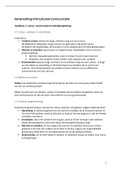Exam (elaborations)
AC1.4 Describe media representation of crime
- Institution
- WJEC
These are my answers that I used to achieve a 94/100 raw marks on the Year 12 Unit 1 Criminology controlled assessment which then resulted in me getting 100/100 UMS marks. When completing my controlled assessment, these answers were the structure I used however I changed it according to the brief. ...
[Show more]









